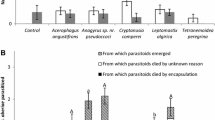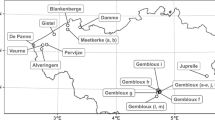Abstract
Parasitism ofLygus lineolaris (Palisot de Beauvois) eggs by three species ofMymaridae, Anaphes iole Girault,Erythmelus miridiphagus Dozier andPolynema pratensiphagum Walley and one species ofScelionidae, Telenomus sp., was investigated at Ste-Anne-de-Bellevue, Québec. The maximum level of field parasitism ofL. lineolaris eggs by individual species was 15.4, 53.8, 70.0 and 16,7%, respectively.
Parasitoids were retrieved from eggs ofL. lineolaris inserted in stems and branches ofAmaranthus retroflexus L.,Chenopodium album L.,Coronilla varia L.,Rumex obtusifolius L. andSolanum tuberosum L.
Amaranthus retroflexus andS. tuberosum sustained a large population ofL. lineolaris and egg parasitism was high enough to consider it as a potential control factor.
Résumé
Le parasitisme des œufs deLygus lineolaris par trois espèces deMymaridae, Anaphes iole, Erythmelus miridiphagus etPolynema pratensiphagum et une espèce deScelionidae, Telenomus sp. a été observé à Ste-Anne-de-Bellevue, Québec. Le niveau maximal de parasitisme observé au champ pour chaque espèce a été respectivement de 15,4, 53,8, 70,0 et 16,7%.
Les parasitoïdes étaient obtenus d'œufs deL. lineolaris insérés dans des tiges et des branches d'Amaranthus retroflexus, Chenopodium album, Coronilla varia, Rumex obtusifolius etSolanum tuberosum.
A. retroflexus etS. tuberosum portaient une population élevée deL. lineolaris et le parasitisme des œufs était suffisamment élevé pour que l'on puisse considérer qu'il constitue un facteur important de limitation des populations de la punaise.
Similar content being viewed by others
References
Boivin, B. &Stewart, R. K. — 1983. Seasonal development and interplant movements of phytophagous mirids (Hemiptera: Miridae) on alternate host plants in and around an apple orchard.Ann. entomol. Soc. Am., 76, 776–780.
Graham, H. M., Negm, A. A., Ertle, L. R. — 1984. Worldwide literature of theLygus complex (Hemiptera: Miridae), 1900–1980. USDA, ARS Bibliogr. Lit. Agr. 30, 205 p.
Graham, H. M., Jackson, C. G. &Debolt, J. W. — 1986.Lygus spp. (Hemiptera: Miridae) and their parasites in agricultural areas of southern Arizona.Environ. Entomol., 15, 132–142.
Greathead, D. J. — 1986. Parasitoids in classical biological control, p. 289–318. In: Insect parasitoids (J. Waage &D. J. Greathead, eds.) 13th symp. R. Entomol. Soc. London, 18–19 September 1985,Academic Press, London, 389 p.
Hauschild, K. I. &Parker, B. L. — 1976. Seasonal development of the tarnished plant bug on apple in Vermont.Environ. Entomol., 5, 675–679.
Huber, J. T. andRajakulendran, V. K. — 1988. Redescription of and host-induced antennal variation inAnaphes iole Girault (Hemiptera) in North America.Can. Ent., 120, 893–901.
Jones, W. A. & Young, O. P. — 1988. Prospects for biological control ofLygus. In: Proc. XVII International Congress of Entomology, Vancouver, B. C., Canada, July 3–9, 1988.
Khattat, A. R. &Stewart, R. K. — 1980. Populations fluctuations and interplant movements ofLygus lineolaris.Ann. entomol. Soc. Am., 73, 282–287.
Khoury, H. &Stewart, R. K. — 1976. Chemical control ofLygus lineolaris (P. de B.) (Heteroptera: Miridae) on growing crops of celery and potato in Québec.Ann. entomol. Soc. Qué., 21, 39–48.
Lim, K. P. &Stewart, R. K. — 1976. Parasitism of the tarnished plant bug,Lygus lineolaris (Hemiptera: Miridae) byPeristenus pallipes andP. pseudopallipes (Hymenoptera: Braconidae).An. Entomol., 108; 601–608.
Painter, R. H. — 1929. The tarnished plant bug,Lygus pratensis L. A progress report.Entomol. Soc. Ont. Annu. Rep., 60, 102–107.
Poston, F. L. &Pedigo, L. P. — 1975. Migration of plant bugs and the potato leafhopper in a soybean-alfalfa complex.Environ. Entomol., 4, 8–10.
Scales, A. L. — 1973. The parasites of the tarnished plant bug in the Mississipi Delta.Environ. Entomol., 2, 304–306.
Scott, D. R. — 1987. Biological control of lygus bugs on vegetables and fruit crops, pp. 40–47. InR. C. Hedlund & H. M. Graham [eds.], Economic importance and biological control ofLygus andAdelphocoris in North America. USDA, ARS-64, 95 p.
Sillings, J. O. — 1971. The parasites of the tarnished plant bug,Lygus lineolaris in Indiana.Proc. North Central Branch. entomol. Soc. Am., 26, 105.
Sillings, J. O. &Broersma, D. B. — 1974. The parasites of the tarnished plant bug,Lygus lineolaris in Indiana.Proc. North Central Branch. Entomol. Soc. Am., 29, 120–125.
Sohati, P. H., Stewart, R. K. &Boivin, G. — 1989. Egg parasitoids of the tarnished plant bug,Lygus lineolaris (P. de B.) (Hemiptera: Miridae) in Québec.Can. Entomol., 121, 1127–1128.
Stewart, R. K. &Khoury, H. — 1976. The biology ofLygus lineolaris (Palisot de Beauvois) (Hemiptera: Miridae) in Québec.Ann. Soc. entomol. Qué., 21, 52–63.
Author information
Authors and Affiliations
Rights and permissions
About this article
Cite this article
Sohati, P.H., Boivin, G. & Stewart, R.K. Parasitism ofLygus lineolaris eggs onCoronilla varia, solanum tuberosum, and three host weeds in southeastern Québec. Entomophaga 37, 515–523 (1992). https://doi.org/10.1007/BF02372321
Received:
Accepted:
Issue Date:
DOI: https://doi.org/10.1007/BF02372321




